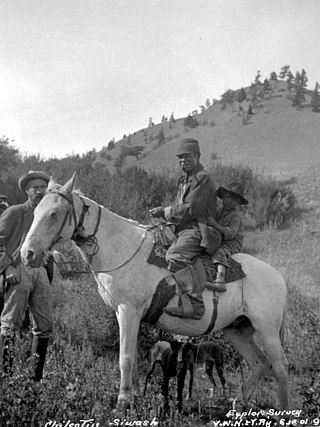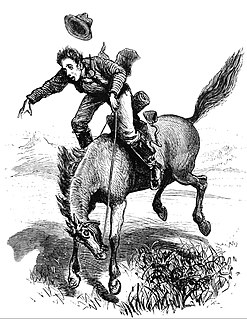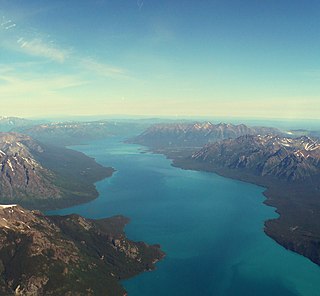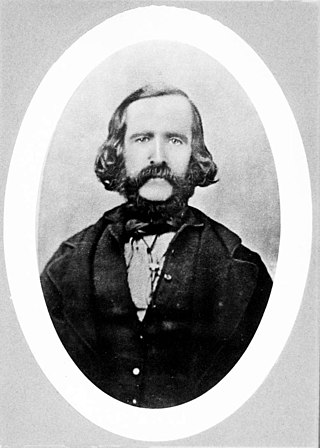Related Research Articles

The Tsilhqotʼin or Chilcotin are a North American tribal government of the Athabaskan-speaking ethnolinguistic group that live in what is now known as British Columbia, Canada. They are the most southern of the Athabaskan-speaking Indigenous peoples in British Columbia.
The Chilcotin region of British Columbia is usually known simply as "the Chilcotin", and also in speech commonly as "the Chilcotin Country" or simply Chilcotin. It is a plateau and mountain region in British Columbia on the inland lee of the Coast Mountains on the west side of the Fraser River. Chilcotin is also the name of the river draining that region. In the language of the Chilcotin people their name and the name of the river means "people of the red ochre river"

Cayuse is an archaic term used in the American West, originally referring to a small landrace horse, often noted for unruly temperament. The name came from the horses of the Cayuse people of the Pacific Northwest. The term came to be used in a derogatory fashion to refer to any small, low-quality horse, particularly if owned by indigenous people or a feral horse.

Tŝilhqox Biny, known as Chilko Lake, is a 180 km2 lake in west-central British Columbia, at the head of the Chilko River on the Chilcotin Plateau. The lake is about 65 km long, with a southwest arm 10 km long. It is one of the largest lakes by volume in the province because of its great depth, and the largest above 1,000 m in elevation. It and Harrison Lake are the largest lakes in the southern Coast Mountains.

The Chilko River is a 75-kilometre-long (47 mi) river in the Chilcotin District of the Central Interior of British Columbia, Canada, flowing northeast from Chilko Lake to the Chilcotin River. Its main tributary is the Taseko River.

Tŝ’ilʔoŝ, also known as Mount Tatlow, is one of the principal summits of the Chilcotin Ranges subdivision of the Pacific Ranges of the Coast Mountains of southern British Columbia. Standing on an isolated ridge between the lower end of Chilko Lake and the Taseko Lakes, it is 3,063 m (10,049 ft) in elevation.

Bute Inlet is one of the principal inlets of the British Columbia Coast. It is 80 km (50 mi) long from the estuaries of the Homathko and Southgate Rivers at the head of the inlet, to the mouth, where it is nearly blocked by Stuart Island, and it averages about 4 km (2.5 mi) in width. Bute Inlet is in a spectacular wilderness setting and is one of the most scenic waterways in the world. In the upper reaches of the inlet mountains rise 2,700 m (9,000 ft) feet above sea level. Bute Inlet is a spectacular wilderness that is visited by very few people. In more recent years tourists are travelling from around the world to view grizzly bears in a natural setting and explore the wilderness of Bute Inlet.

Tsʼilʔos Provincial Park is a provincial park in British Columbia, Canada. Tsʼilʔos is the official BC Parks designation for this provincial park, though sometimes it is written as "Ts'il-os", "Ts'yl-os", or "Tsylos". The "ʔ" in the name represents a glottal stop.
Lhatŝ’aŝʔin, a chief of the Chilcotin (Tsilhqot'in) people, led a small group of warriors in attacks on road-building crews near Bute Inlet, British Columbia, in April and May 1864. The road crews had been starving and underpaying Tsilhqot'in workers, which provoked Lhatŝ’aŝʔin to declare war. On 29 April 1864, Lhatŝ’aŝʔin arrived at a ferry site 30 mi (48 km) up the Homathko River. He and his warriors killed ferry-keeper Tim Smith, plundering the food and stores kept there.
The Carrier-Chilcotin Tribal Council is a First Nations tribal council located in the Chilcotin District of the Central Interior of the Canadian province of British Columbia, and also on the Fraser River near the city of Quesnel. It consists of three Carrier bands and one Tsilhqot'in band. The other Tsilhqot'in bands belong to the Tsilhqot'in National Government. Most other Carrier bands are either unaffiliated or belong to the Carrier-Sekani Tribal Council. The Tribal Council's offices are in Williams Lake.
The Xeni Gwet'in First Nation is a First Nations government located in the southwestern Chilcotin District in the western Central Interior region of the Canadian province of British Columbia. It is a member of the Tsilhqot'in Tribal Council.
Xeni can refer to:
Nemaiah Valley, also spelled Nemiah Valley and Nemaia Valley, is an unincorporated locality and First Nations reserve and ranching community between Chilko Lake and the Taseko Lakes in the Chilcotin District of the Central Interior of British Columbia.

The Tsilhqot'in National Government (TNG), is the official First Nations government serving the Tsilhqot'in Nation. Their office is located in Williams Lake, British Columbia, Canada. The member communities represented by TNG are ʔEsdilagh, Tsi Del Del, Yunesit'in, Tl'etinqox, Xeni Gwet'in, and Tl'esqox. Tl'esqox also belongs to the Carrier-Chilcotin Tribal Council, as does Ulkatcho - a community with both Dakelh (Carrier) & Tsilhqot'in heritage. TNG was established in 1989.

Donald McLean, also known as Samadlin, a First Nations adaptation of Sieur McLean, was a Scottish fur trader and explorer for the Hudson's Bay Company and who later became a cattle rancher near Cache Creek in British Columbia's Thompson Country. McLean was the last casualty of the Chilcotin War of 1864 and the father of outlaw and renegade Allan McLean, leader of the "Wild McLean Boys" gang.

Tatlayoko Lake is a lake on the Homathko River in the western Chilcotin District of the Central Interior of British Columbia, Canada, located on a north-south axis just upstream of the entrance of the series of canyons of the Homathko, including the Great Canyon of the Homathko, on its route to the sea at the head of Bute Inlet. The community of Tatlayoko Lake, British Columbia is located at its northern end.
Gunn Valley is a valley in the southern Chilcotin District of the Central Interior of British Columbia, Canada, just west of the Taseko Lakes and, like them, running on a north–south axis and at a perpendicular angle to Yohetta Valley, which drains to it via Yohetta Creek but also connects through a low pass to Chilko Lake farther west. In Gunn Valley are Tuzcha and Fishem Lakes, which are fed and drained by Yohetta Creek, which joins the Tchaikazan River at the valley's southern end. Lastman Lake is at the valley's north end and is connected to the other lakes by a swampy pass, through which runs the access road to Yohetta Valley. There is an airstrip near the valley's southern end.
The lack of treaties between the First Nations of British Columbia (BC) and the Canadian Crown, is a long-standing problem that has become a major issue in recent years. In 1763, the British Crown declared that only it could acquire land from First Nations through treaties. Historically only two treaties were signed with the First Nations of British Columbia. The first of which was the Douglas Treaties, negotiated by Sir James Douglas with the native people of southern Vancouver Island from 1850-1854. The second treaty, Treaty 8, signed in 1899 was part of the Numbered Treaties that were signed with First Nations across the Prairie regions. British Columbian Treaty 8 signatories are located in the Peace River Country or the far North East of BC. For over nine decades no more treaties were signed with First Nations of BC; many Native people wished to negotiate treaties, but successive BC provincial governments refused until the 1990s. A major development was the 1997 decision of the Supreme Court of Canada in the Delgamuukw v. British Columbia case that Aboriginal title still exists in British Columbia and that when dealing with Crown land, the government must consult with and may have to compensate First Nations whose rights are affected.

Tsilhqot'in Nation v British Columbia is a landmark decision of the Supreme Court of Canada that established Aboriginal land title for the Tsilhqot'in First Nation, with larger effects. As a result of the landmark decision, provinces cannot unilaterally claim a right to engage in clearcut logging on lands protected by Aboriginal title; they must engage in meaningful consultation with the title holder before they proceed. Although the Aboriginal title holder does not have to consent to the activity, meaningful consultation is required before infringement of the right can take place.
Marilyn Baptiste is a former Chief of the Xeni Gwet'in First Nation in British Columbia, Canada.